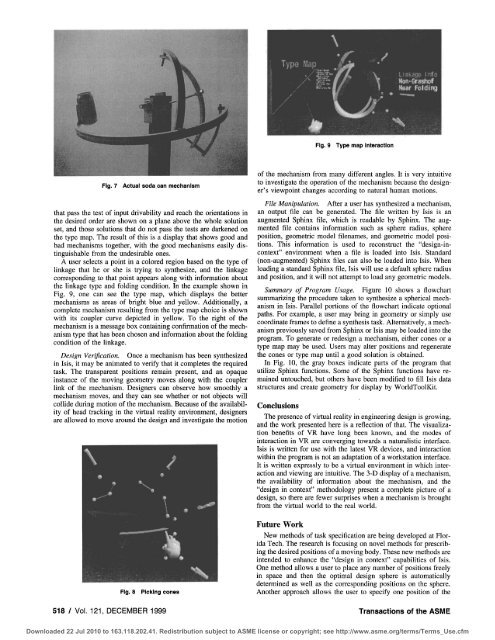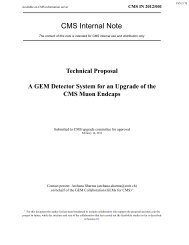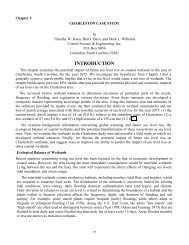Spherical Mechanism Synthesis in Virtual Reality - Florida Institute ...
Spherical Mechanism Synthesis in Virtual Reality - Florida Institute ...
Spherical Mechanism Synthesis in Virtual Reality - Florida Institute ...
You also want an ePaper? Increase the reach of your titles
YUMPU automatically turns print PDFs into web optimized ePapers that Google loves.
Fig. 7 Actual soda can mechanism<br />
that pass the test of <strong>in</strong>put drivability and reach the orientations <strong>in</strong><br />
the desired order are shown on a plane above the whole solution<br />
set, and those solutions that do not pass the tests are darkened on<br />
the type map. The result of this is a display that shows good and<br />
bad mechanisms together, with the good mechanisms easily dist<strong>in</strong>guishable<br />
from the undesirable ones.<br />
A user selects a po<strong>in</strong>t <strong>in</strong> a colored region based on the type of<br />
l<strong>in</strong>kage that he or she is try<strong>in</strong>g to synthesize, and the l<strong>in</strong>kage<br />
correspond<strong>in</strong>g to that po<strong>in</strong>t appears along with <strong>in</strong>formation about<br />
the l<strong>in</strong>kage type and fold<strong>in</strong>g condition. In the example shown <strong>in</strong><br />
Fig. 9, one can see the type map, which displays the better<br />
mechanisms as areas of bright blue and yellow. Additionally, a<br />
complete mechanism result<strong>in</strong>g from the type map choice is shown<br />
with its coupler curve depicted <strong>in</strong> yellow. To the right of the<br />
mechanism is a message box conta<strong>in</strong><strong>in</strong>g confirmation of the mechanism<br />
type that has been chosen and <strong>in</strong>formation about the fold<strong>in</strong>g<br />
condition of the Unkage.<br />
Design Verification. Once a mechanism has been synthesized<br />
<strong>in</strong> Isis, it may be animated to verify that it completes the required<br />
task. The transparent positions rema<strong>in</strong> present, and an opaque<br />
<strong>in</strong>stance of the mov<strong>in</strong>g geometry moves along with the coupler<br />
l<strong>in</strong>k of the mechanism. Designers can observe how smoothly a<br />
mechanism moves, and they can see whether or not objects will<br />
collide dur<strong>in</strong>g motion of the mechanism. Because of the availability<br />
of head track<strong>in</strong>g <strong>in</strong> the virtual reality environment, designers<br />
are allowed to move around the design and <strong>in</strong>vestigate the motion<br />
Fig. 8 Pick<strong>in</strong>g cones<br />
518 / Vol. 121, DECEMBER 1999<br />
Fig. 9 Type map Interaction<br />
of the mechanism from many different angles. It is very <strong>in</strong>tuitive<br />
to <strong>in</strong>vestigate the operation of the mechanism because the designer's<br />
viewpo<strong>in</strong>t changes accord<strong>in</strong>g to natural human motions.<br />
File Manipulation. After a user has synthesized a mechanism,<br />
an output file can be generated. The file written by Isis is an<br />
augmented Sph<strong>in</strong>x file, which is readable by Sph<strong>in</strong>x. The augmented<br />
file conta<strong>in</strong>s <strong>in</strong>formation such as sphere radius, sphere<br />
position, geometric model filenames, and geometric model positions.<br />
This <strong>in</strong>formation is used to reconstruct the "design-<strong>in</strong>context"<br />
environment when a file is loaded <strong>in</strong>to Isis. Standard<br />
(non-augmented) Sph<strong>in</strong>x files can also be loaded <strong>in</strong>to Isis. When<br />
load<strong>in</strong>g a standard Sph<strong>in</strong>x file, Isis will use a default sphere radius<br />
and position, and it will not attempt to load any geometric models.<br />
Summary of Program Usage. Figure 10 shows a flowchart<br />
summariz<strong>in</strong>g the procedure taken to synthesize a spherical mechanism<br />
<strong>in</strong> Isis. Parallel portions of the flowchart <strong>in</strong>dicate optional<br />
paths. For example, a user may br<strong>in</strong>g <strong>in</strong> geometry or simply use<br />
coord<strong>in</strong>ate frames to def<strong>in</strong>e a synthesis task. Alternatively, a mechanism<br />
previously saved from Sph<strong>in</strong>x or Isis may be loaded <strong>in</strong>to the<br />
program. To generate or redesign a mechanism, either cones or a<br />
type map may be used. Users may alter positions and regenerate<br />
the cones or type map until a good solution is obta<strong>in</strong>ed.<br />
In Fig. 10, the gray boxes <strong>in</strong>dicate parts of the program that<br />
utilize Sph<strong>in</strong>x functions. Some of the Sph<strong>in</strong>x functions have rema<strong>in</strong>ed<br />
untouched, but others have been modified to fill Isis data<br />
structures and create geometry for display by WorldToolKit.<br />
Conclusions<br />
The presence of virtual reality <strong>in</strong> eng<strong>in</strong>eer<strong>in</strong>g design is grow<strong>in</strong>g,<br />
and the work presented here is a reflection of that. The visualization<br />
benefits of VR have long been known, and the modes of<br />
<strong>in</strong>teraction <strong>in</strong> VR are converg<strong>in</strong>g towards a naturalistic <strong>in</strong>terface.<br />
Isis is written for use with the latest VR devices, and <strong>in</strong>teraction<br />
with<strong>in</strong> the program is not an adaptation of a workstation <strong>in</strong>terface.<br />
It is written expressly to be a virtual environment <strong>in</strong> which <strong>in</strong>teraction<br />
and view<strong>in</strong>g are <strong>in</strong>tuitive. The 3-D display of a mechanism,<br />
the availability of <strong>in</strong>formation about the mechanism, and the<br />
"design <strong>in</strong> context" methodology present a complete picture of a<br />
design, so there are fewer surprises when a mechanism is brought<br />
from the virtual world to the real world.<br />
Future Work<br />
New methods of task specification are be<strong>in</strong>g developed at <strong>Florida</strong><br />
Tech. The research is focus<strong>in</strong>g on novel methods for prescrib<strong>in</strong>g<br />
the desired positions of a mov<strong>in</strong>g body. These new methods are<br />
<strong>in</strong>tended to enhance the "design <strong>in</strong> context" capabilities of Isis.<br />
One method allows a user to place any number of positions freely<br />
<strong>in</strong> space and then the optimal design sphere is automatically<br />
determ<strong>in</strong>ed as well as the correspond<strong>in</strong>g positions on the sphere.<br />
Another approach allows the user to specify one position of the<br />
Transactions of the ASME<br />
Downloaded 22 Jul 2010 to 163.118.202.41. Redistribution subject to ASME license or copyright; see http://www.asme.org/terms/Terms_Use.cfm
















